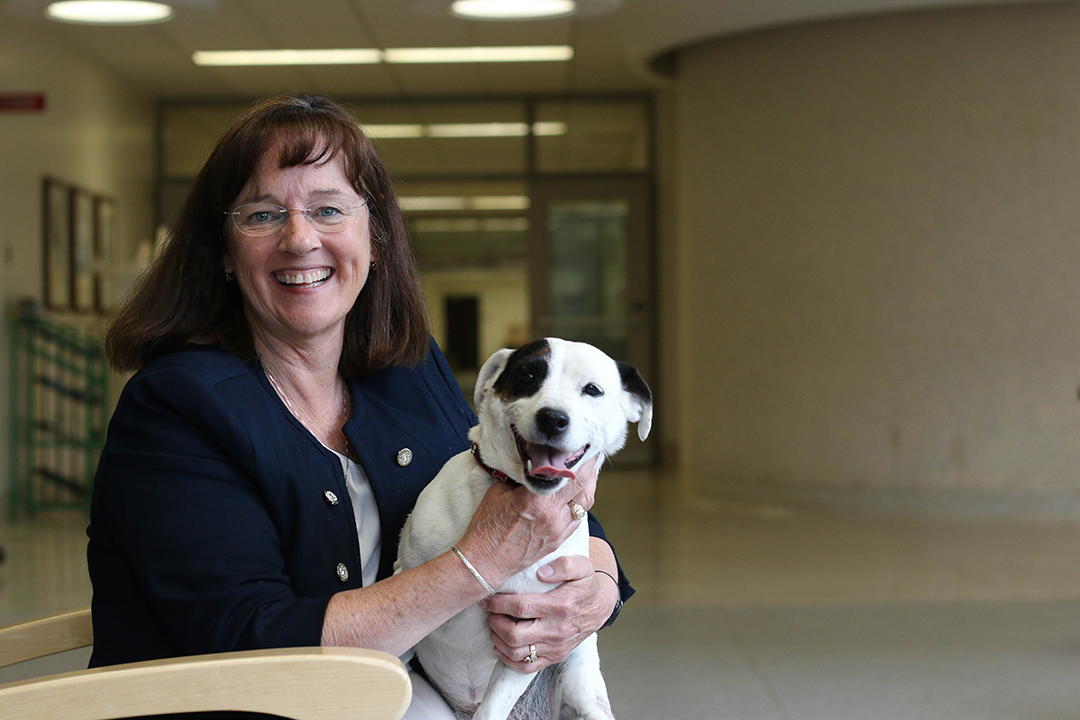
Does Fido really need that antibiotic?
Most people know the dangers of taking antibiotic drugs for a flu or cold that doesn’t require treatment, but do pet owners understand that the same rules apply for their beloved dogs and cats?
By Ali StaleyWhen human physicians or veterinarians use antibiotics unnecessarily or inappropriately, they may be promoting antibiotic resistance. The result: infections can be more difficult to treat, and medical professionals are left with a dwindling arsenal of effective antibiotic drugs.
The first step in using antibiotics appropriately is to make sure that there’s an accurate diagnosis of an infection, which is the focus of study being conducted by researchers at the Western College of Veterinary Medicine (WCVM) and Prairie Diagnostic Services (PDS) — the veterinary laboratory for Saskatchewan. Led by veterinary pharmacologist Dr. Trisha Dowling, the team is investigating the accuracy of veterinary clinic tests used to diagnose urinary tract infections (UTIs) — the most common bacterial infection of dogs.
Veterinarians diagnose UTIs based upon the patient’s medical history, physical examination findings, and evaluation of the urine and bacterial culture. Urine culture by a diagnostic laboratory is considered the “gold standard” for diagnosis, but veterinary clinics often presumptively diagnose UTIs by looking at a sample under a microscope for evidence of bacteria and white blood cells. Automated urine analyzers are another in-clinic diagnostic tool.
However, microbiologists at PDS have received frequent complaints of in-clinic evidence of a UTI only to have negative bacterial culture results.
In response, the WCVM-PDS research team applied for and received funding from Zoetis Animal Health to investigate the accuracy of in-clinic urine examination for the diagnosis of canine UTIs. Veterinarians participating in the study first had to make a diagnosis of a UTI in a dog using their normal clinic procedure. Then, they submitted a sample to PDS for free urinalysis and urine culture and susceptibility testing.
At the end of the study, researchers found that 41 per cent of the dogs considered by practitioners to have a UTI did not have evidence of infection on urinalysis and had no bacterial growth on culture. Urinalysis and culture were consistent with urinary tract infection in 49 per cent of the cases.
Only rarely were there cases where the urinalysis indicated infection but bacteria did not grow on culture — a result that could occur because of prior treatment with antibiotics or sample damage.
While this study is important for demonstrating the clear value of using a diagnostic laboratory for accurate diagnosis, it was also an opportunity for the researchers to identify a typical canine urinary tract infection in Saskatchewan.
“From the results seen, the bacteria causing UTI in dogs are routinely susceptible to first-line antibiotics,” says Dowling, adding that no real “superbugs” were seen in the study’s patients.
Since any use of antibiotics can have a profound impact on both human and animal health, the big question is why aren’t veterinary clinics using diagnostic laboratory tests more frequently?
Dowling says many pet owners are concerned about the costs involved in using diagnostic tests. Plus, it’s often difficult to collect urine samples from pets — a problem for pet owners and veterinarians. There’s also the time factor: it takes several days to get the samples to a laboratory and then get results.
Because of these reasons, there’s pressure “to try a course of antibiotics and just see how the dog responds,” says Dowling. But if the dog never had an actual infection in the first place, it’s easy to assume that the antibiotic “worked.” And treating the non-existing UTI exposes all of the dog’s normal bacteria on its skin and in its gastrointestinal tract to the antibiotic, which can select for antibiotic-resistant bacteria.
Dowling hopes their research findings will benefit companion animal veterinarians across Canada who can point to the study’s results as proof that accurate diagnostic testing is essential — a key message in a national campaign aimed at promoting antimicrobial stewardship to pet owners.
The WCVM and PDS research team’s antimicrobial study is financially supported by the Zoetis Investment in Innovation Fund.
Ali Staley of Saskatoon, Sask., is a third-year veterinary student at WCVM. Her story is part of a series of articles written by the veterinary college’s summer research students. This article originally appeared in the Spring 2019 edition of Vet Topics, the official publication of the WCVM's Companion Animal Health Fund.
